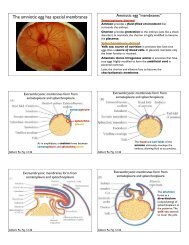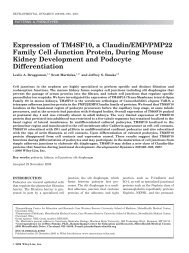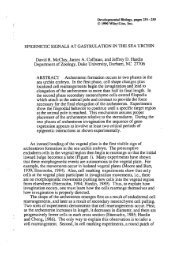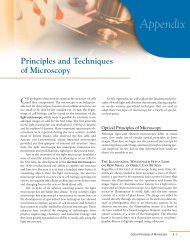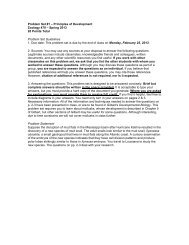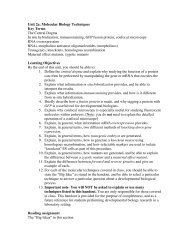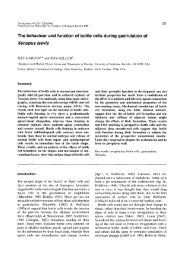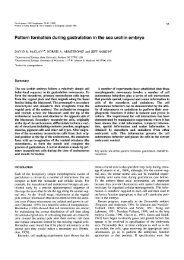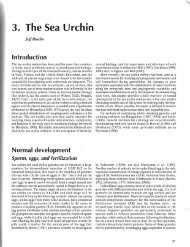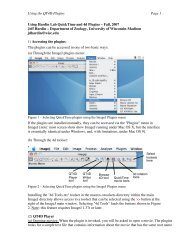Problem Set #3 ? Left/right (L/R) axis specification Zoology 470 ...
Problem Set #3 ? Left/right (L/R) axis specification Zoology 470 ...
Problem Set #3 ? Left/right (L/R) axis specification Zoology 470 ...
You also want an ePaper? Increase the reach of your titles
YUMPU automatically turns print PDFs into web optimized ePapers that Google loves.
<strong>Problem</strong> <strong>Set</strong> <strong>#3</strong> – <strong>Left</strong>/<strong>right</strong> (L/R) <strong>axis</strong> <strong>specification</strong><br />
<strong>Zoology</strong> <strong>470</strong> – Spring 2013<br />
20 Points Total<br />
<strong>Problem</strong> <strong>Set</strong> Guidelines<br />
1. Due date: This problem set is due by the end of class, on Monday, May 6, 2013, or you must make<br />
prior arrangements to submit it before the end of class on May 6.<br />
2. Sources: You may use any sources at your disposal to answer the following questions.<br />
Legitimate sources include classmates, knowledgeable friends and colleagues, written<br />
documents, and any other scientific resources you find useful. If you work with other<br />
classmates on this problem set, we ask that you list the other students with whom you<br />
worked to answer these questions. Although you may discuss these questions as part of a<br />
group, you are expected to answer the questions as an individual. If you believe that<br />
published references will help you answer these questions, you may cite those references.<br />
However, citation of additional references is not required, nor is it expected.<br />
3. Answering the questions: This problem set is designed to be answered concisely. Brief but<br />
complete answers should be written in the space provided. You need only turn in your<br />
answers on pages 1 & 2. Necessary information: The following questions involve experimental<br />
and/or genetic manipulation of left/<strong>right</strong> <strong>axis</strong> <strong>specification</strong> in various vertebrates. All of the<br />
information and techniques needed to answer the questions on p. 1-2 have been presented in<br />
class, or are to be found in Gilbert's Developmental Biology, 9e, Chapters 7 & 8. Complete<br />
answers may require you to recall information from previous units in this course,<br />
especially the question labeled "integrative" (question #2).<br />
Although much of this material is covered in your textbook, you may find the following paper<br />
helpful:<br />
Kramer-Zucker AG, Olale F, Haycraft CJ, Yoder BK, Schier AF, Drummond IA. (2005). Ciliadriven<br />
fluid flow in the zebrafish pronephros, brain and Kupffer's vesicle is required for normal<br />
organogenesis. Development 132:1907-21.
Zoo <strong>470</strong> – 2013 – <strong>Problem</strong> <strong>Set</strong> <strong>#3</strong> Page 1<br />
Name:________________________________ Student Number:__________________<br />
If you worked in a group, other collaborators:____________________________________<br />
1. After graduating with an "A" in Zoo <strong>470</strong> you proceed through medical school and are beginning<br />
your first internship in the emergency room. You are presented with a male patient who displays<br />
clear symptoms of acute appendicitis (the appendix, located near the waist, usually on the <strong>right</strong> side<br />
of the body, can become inflamed and must then be removed quickly before it can rupture and<br />
cause a severe peritoneal infection). A quick check of the patient's medical records reveals a history<br />
of sterility and recurrent bronchial infections. You place your stethoscope on the left side of his chest,<br />
and can detect no heartbeat. After checking one more thing, you decide not to call in the heart failure<br />
unit and to proceed with the appendectomy.<br />
a) What convinced you not to worry about heart failure? (1 point)<br />
b) In beginning the appendectomy, where should you make your incision? Explain your rationale<br />
briefly. (1 point)<br />
c) Further checking of the patient’s family medical history reveals that his condition is hereditary,<br />
resulting from an autosomal recessive mutation. How can a mutation in a single gene cause the<br />
collection of symptoms this patient presents (not including the appendicitis!), and what is the primary<br />
defect likely to be? Explain briefly. (3 points)<br />
2. Integrative question: The polycystic kidney disease gene, pkd2, is associated with left/<strong>right</strong><br />
defects.<br />
a. A naturally occurring mutation in the mouse pkd2 gene does not exist. What technique do you<br />
predict was used to generate pkd2 loss-of-function mutants? (1 point)<br />
Technique used: ___________________________<br />
b. The pkd2 (polycystin-2) protein is a calcium-activated cation channel protein, i.e., it is thought to<br />
allow regulated entry of cations into cells. You believe that pkd2 may regulate calcium levels within cells<br />
of the mouse node. It is possible to culture mouse embryos at the stage of development at which<br />
left/<strong>right</strong> <strong>axis</strong> <strong>specification</strong> is occurring. Assume that experiments that can be done in early embryos in<br />
a variety of species can be performed on such cultured mouse embryos. Design an experiment that<br />
would show that loss of pkd2 function affects calcium levels within cells in or near the node (3 points)
Zoo <strong>470</strong> – 2013 – <strong>Problem</strong> <strong>Set</strong> <strong>#3</strong> Page 1<br />
3. You are a new student in Cliff Tabin's lab at Harvard, and you are learning how to overexpress<br />
proteins in chick embryos at the time when L/R/ <strong>axis</strong> <strong>specification</strong> occurs. Overexpression of soluble<br />
proteins can be performed by implanting a bead soaked in the soluble molecule, which then diffuses<br />
out of the bead to nearby tissues. Proteins that are normally found inside cells can be overexpressed<br />
by infecting cells with a genetically engineered virus that encodes the protein of interest. When cells<br />
are infected, the viral genome directs expression of the protein within the infected cell(s).<br />
a. Predict what would happen in each of the following situations (6 points):<br />
Experiment Expected effect on L/R <strong>axis</strong> Reasoning<br />
Overexpress the<br />
chick nodal<br />
protein on the<br />
<strong>right</strong> side of the<br />
embryo<br />
Overexpress<br />
pitx2 on the left<br />
side of the<br />
embryo<br />
b. Of the two techniques described above for overexpressing protein in chicks, which technique<br />
would you use to perform the pitx2 overexpression experiment listed in (a), based on your<br />
knowledge of the type of protein the pitx2 gene encodes? Briefly state your reasoning (1 point)<br />
4. The polaris gene in mice is required for a process known as intraflagellar transport (IFT). IFT is<br />
required for formation of cilia. Ian Drummond’s lab examined effects of knockdown of zebrafish<br />
polaris on pitx2 expression.<br />
a. Would you expect pitx2 expression to be normal in zebrafish embryos knocked down for polaris?<br />
Explain your answer (3 points)<br />
b. Drummond’s lab also examined fluid flow associated with the ciliated structure that is the<br />
equivalent of the node in the mouse following polaris knockdown. What is this structure? (1 point)<br />
Specific zebrafish structure causing fluid flow: _______________________<br />
c. Extra credit: What celestial object has the name Polaris? (1 point)



